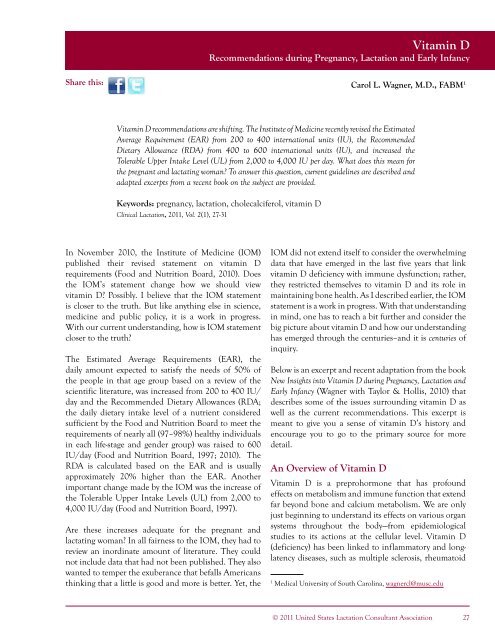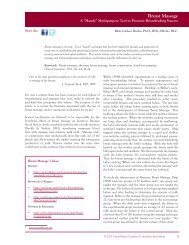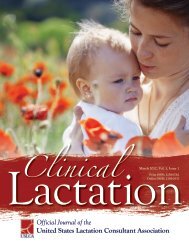Vitamin D Recommendations During Pregnancy ... - Clinical Lactation
Vitamin D Recommendations During Pregnancy ... - Clinical Lactation
Vitamin D Recommendations During Pregnancy ... - Clinical Lactation
- No tags were found...
You also want an ePaper? Increase the reach of your titles
YUMPU automatically turns print PDFs into web optimized ePapers that Google loves.
<strong>Vitamin</strong> D<strong>Recommendations</strong> during <strong>Pregnancy</strong>, <strong>Lactation</strong> and Early InfancyShare this:Carol L. Wagner, M.D., FABM 1<strong>Vitamin</strong> D recommendations are shifting. The Institute of Medicine recently revised the EstimatedAverage Requirement (EAR) from 200 to 400 international units (IU), the RecommendedDietary Allowance (RDA) from 400 to 600 international units (IU), and increased theTolerable Upper Intake Level (UL) from 2,000 to 4,000 IU per day. What does this mean forthe pregnant and lactating woman? To answer this question, current guidelines are described andadapted excerpts from a recent book on the subject are provided.Keywords: pregnancy, lactation, cholecalciferol, vitamin D<strong>Clinical</strong> <strong>Lactation</strong>, 2011, Vol. 2(1), 27-31In November 2010, the Institute of Medicine (IOM)published their revised statement on vitamin Drequirements (Food and Nutrition Board, 2010). Doesthe IOM’s statement change how we should viewvitamin D? Possibly. I believe that the IOM statementis closer to the truth. But like anything else in science,medicine and public policy, it is a work in progress.With our current understanding, how is IOM statementcloser to the truth?The Estimated Average Requirements (EAR), thedaily amount expected to satisfy the needs of 50% ofthe people in that age group based on a review of thescientific literature, was increased from 200 to 400 IU/day and the Recommended Dietary Allowances (RDA;the daily dietary intake level of a nutrient consideredsufficient by the Food and Nutrition Board to meet therequirements of nearly all (97–98%) healthy individualsin each life-stage and gender group) was raised to 600IU/day (Food and Nutrition Board, 1997; 2010). TheRDA is calculated based on the EAR and is usuallyapproximately 20% higher than the EAR. Anotherimportant change made by the IOM was the increase ofthe Tolerable Upper Intake Levels (UL) from 2,000 to4,000 IU/day (Food and Nutrition Board, 1997).Are these increases adequate for the pregnant andlactating woman? In all fairness to the IOM, they had toreview an inordinate amount of literature. They couldnot include data that had not been published. They alsowanted to temper the exuberance that befalls Americansthinking that a little is good and more is better. Yet, theIOM did not extend itself to consider the overwhelmingdata that have emerged in the last five years that linkvitamin D deficiency with immune dysfunction; rather,they restricted themselves to vitamin D and its role inmaintaining bone health. As I described earlier, the IOMstatement is a work in progress. With that understandingin mind, one has to reach a bit further and consider thebig picture about vitamin D and how our understandinghas emerged through the centuries–and it is centuries ofinquiry.Below is an excerpt and recent adaptation from the bookNew Insights into <strong>Vitamin</strong> D during <strong>Pregnancy</strong>, <strong>Lactation</strong> andEarly Infancy (Wagner with Taylor & Hollis, 2010) thatdescribes some of the issues surrounding vitamin D aswell as the current recommendations. This excerpt ismeant to give you a sense of vitamin D’s history andencourage you to go to the primary source for moredetail.An Overview of <strong>Vitamin</strong> D<strong>Vitamin</strong> D is a preprohormone that has profoundeffects on metabolism and immune function that extendfar beyond bone and calcium metabolism. We are onlyjust beginning to understand its effects on various organsystems throughout the body—from epidemiologicalstudies to its actions at the cellular level. <strong>Vitamin</strong> D(deficiency) has been linked to inflammatory and longlatencydiseases, such as multiple sclerosis, rheumatoid1Medical University of South Carolina, wagnercl@musc.edu© 2011 United States <strong>Lactation</strong> Consultant Association 27
arthritis, lupus, tuberculosis, diabetes, cardiovasculardisease, and various cancers, to name a few. How cansuch a simple “vitamin” be involved in such diversegroups of diseases? What is the mechanism? What doesit mean to you as an individual, practitioner, or publicpolicymaker?There is a renewed interest in vitamin D today. With arise in the prevalence of vitamin D deficiency in variouspopulations across the globe, particularly in individualsof darker pigmentation or with limited access to sunlight,there has been an urgent need to understand why thishas occurred and what effect such deficiency has acrossthe lifespan. Long-standing vitamin D deficiency islinked to a myriad of disease states through its putativeeffect on the immune system.How did we get to this place of widespread vitamin Ddeficiency (Wagner et al., 2008)? Is vitamin D the newvitamin E and vitamin C of the 21st century, the currentfad “cure-all”? Health shows, magazine articles, and thelay press write reviews trying to decipher the plethoraof emerging data that is published on a weekly basisabout the benefits and potential dangers of vitamin Dsupplementation. The individual is inundated with a vastamount of information to decipher, and to ultimatelydecide, what should I do?For pregnant or lactating women, the question becomeseven more important, as it impacts women and theirunborn children, developing newborns, and infants.Health care professionals must weigh the evidence anddecades-old concern that if they supplement a womanwith more than 400 IU vitamin D per day, they willmake her vitamin D toxic and her unborn fetus willbe at risk for birth defects. Public health officialsare faced with the decision of recommending higheramounts of vitamin D in vitamins and revising thenational recommendations of the upper limit of whatis safe for various age groups, or erring on the side ofcaution in maintaining the status quo because it is whathas happened for the last four decades, and it is “safe.”There is always the underlying tenet of “Do no harm,”which must be at the heart of every recommendation.The IOM statement suggests that vitamin D deficiencyis overestimated, yet using their own guidelines of acirculating 25(OH)D level of less than 20 ng/mL, in ourtwo pregnancy studies of over 700 women, more than75% of African American women, 50% of Hispanicwomen, and 20% of Caucasian women met the criteriafor vitamin D deficiency (Hamilton, McNeil et al., 2010).Dangers of <strong>Vitamin</strong> DAs early as the 1920s, reports of vitamin D toxicitysurfaced. In an era when individual levels were noteasily and reliably measured to document “deficiency”or “sufficiency,” individuals were prescribed or givenhundreds of thousands of IU’s of vitamin D takenfor weeks or months, which resulted in the classicsymptomatology of toxicity. With careful, meticulousstudy, definitive “proof” of vitamin D’s toxicity andteratogenicity surfaced in the early 1960s. In 1963,Black and Bonham-Carter recognized that elfin faciesobserved in patients with severe idiopathic infantilehypercalcemia resembled peculiar facies observedin patients with supravalvular aortic stenosis (SAS)syndrome. Shortly thereafter, Garcia et al. (1964)documented the occurrence of idiopathic hypercalcemiain an infant with SAS. The infant also had peripheralpulmonary stenosis, mental retardation, elfin facies, andan elevated blood concentration of vitamin D.From the 1960s on, there was a rapid decline of rickets,and many believed that modern medicine and sciencehad “cured” rickets. Unfortunately, nutritional ricketsreemerged in the 1980s, particularly among AfricanAmerican and other darkly pigmented populations. Therecurring characteristics of the reported cases were youngThe question arises: If mom’s serum levelsare “normal,” why would you give baby moreoral vitamin D without checking baby’s serumvitamin D levels to see if more is needed? Theanswer is that the amount of vitamin D toachieve the lower level of normal in the motherof 32 ng/mL or 80 nmol/L (in the absenceof sunlight exposure: achieved with a dailyprenatal vitamin containing 400 IU up to 4,000IU/day in some women) does not translate intoadequate levels in her milk, and thus, for herbaby. In this scenario, the mother is repletebut on the lower end so her infant is obligatedto receive 400 IU/day vitamin D to ensureadequacy in that infant. [See Wagner et al.(2006) for more information.]age—particularly infants—darker pigmentation, oftenliving at higher latitudes, and exclusive breastfeedingwithout vitamin D supplementation beyond 6 monthsof age (Rajakumar & Thomas, 2005). This finding ledto a revised American Academy of Pediatrics (AAP)statement in 2003, recommending 200 IU of vitamin28 <strong>Clinical</strong> <strong>Lactation</strong> 2011, Vol. 2-1 Electronic version of this issue is available at www.<strong>Clinical</strong><strong>Lactation</strong>.org
D supplementation to all infants receiving less than 500ml of fortified formula per day to begin within the first 2months of life (Gartner, Greer et al., 2003).Continued reports of rickets, limited dietary sourcesof vitamin D, inadequate sun exposure for vitamin Dsynthesis, and an enhanced understanding of vitaminD physiology and its actions have led to the most recentrevision of the AAP statement in 2008 (Wagner, Greer,& American Academy of Pediatrics, 2008). The currentrecommendations are for all infants and children to besupplemented with a minimum of 400 IU per day ofvitamin D, beginning in the first few days of life (Wagner,Greer et al., 2008). The issue today, however, is not toomuch vitamin D, but rather too little. In the past, themargin of safety of vitamin D was narrow.There was an understandable reluctance to recommendsupplementation for fear of causing toxicity. Withcareful study, it appears that daily vitamin D dosing ofless 10,000 IU/day for extended periods is safe (Heaneyet al., 2003; Vieth, 1999; Vieth & MacFarlane, 2001).<strong>Vitamin</strong> D <strong>Recommendations</strong> for Pregnantand Lactating Women and ChildrenAs we discussed earlier, the recommendations forvitamin D requirements have changed during the pastTable 1. Suggested <strong>Vitamin</strong> D Supplementation Regimen for Pregnant and LactatingWomen, Infants, and ChildrenAge Group Recommended Daily <strong>Vitamin</strong> D Caveats to PonderIntake (IU/day)Neonates 400 IU/day This includes premature neonates and infants.More data are needed to determine what the IU/kg requirements are of preterm infants and neonatesborn to mothers with frank vitamin D deficiency.Infants < 1 year 400 IU/day up to 10 kg; then 25-50IU/kgChildren 1-2 yrs 25-50 IU/kg For example, a child weighing 20 kg would be given500-1,000 IU/day. Another child weighing 25 kgwould be given 625-1,250 IU/day. One could givethe lower dose during summer months and thehigher dose during winter months.Children 2-5 years 25-50 IU/kg up to 30 kgChildren 5-12 25 IU/kg up to 50 kgyearsChildren 12-17 >50 kg 2,000-4,000 IU/day depending on BMIyearsPregnant Women >45 kg 4,000 IU vitamin D/dayLactating Women[This recommendation is based on our two RCT thatwere completed in 2009 (Wagner, Johnson et al.,2010; Wagner, McNeil et al., 2010).]Likely 6,400 IU/day with refinement ofrecommendation once <strong>Lactation</strong> RCT vitamin Dstudies have been completed and analyzed.*This is a conservative guide. If an individual has an increased BMI or a history of malabsorption, then that individual may require higher daily vitaminD supplementation. It would be prudent to check levels if increasing intake beyond these recommendations. The ultimate goal is to attain circulating25(OH)D levels in that individual that would mimic living in a sun-rich environment with daily sun exposure.© 2011 United States <strong>Lactation</strong> Consultant Association 29
century as the views of vitamin D’s role in metabolismand toxicity have changed. It is a work in progress andeach new study that helps us ascertain vitamin D’sfunction within the body in various systems throughthe lifespan challenges our notion of what is required toreach optimal levels. There have been extensive data tosuggest that vitamin D supplementation of 400 IU/dayduring the first year of life is adequate, but whether thatamount is optimal remains to be proved.The American Academy of Pediatrics (AAP)statement in 2003, recommending 200 IU ofvitamin D per day, was based on the IOM’srecommendation at that time centered onpreventing rickets in children. Continuedreports of rickets, limited dietary sources ofvitamin D, inadequate sun exposure for vitaminD synthesis, and an enhanced understanding ofvitamin D physiology and its actions have led tothe most-recent revision of the AAP statementin 2008. The current recommendations are forall infants and children to be supplementedwith a minimum of 400 IU per day of vitaminD, beginning in the first few days of life(Wagner, Greer et al., 2008). (See Chapter 9 ofWagner, with Taylor & Hollis, 2010, for furtherdiscussion on the topic.)One size does not, nor will it ever, fit everyone. Variabilityin where one lives, one’s diet, one’s lifestyle, one’s bodycomposition (fat mass and lean body mass), and theseason affect one’s final vitamin D status. As the childgrows, on a per kilogram basis, 400 IU/day is likelyinsufficient beyond a year, especially in those childrenwith limited milk intake and sunlight exposure, inthose with darker pigmentation, and who live at higherlatitudes. With these caveats in mind, we can ask thequestion yet again: what should one do when it comesto vitamin D? The answer is found Table 1.Children would receive incremental doses of vitamin Dbased on their weight and percent body fat to maintaincirculating 25(OH)D levels, with a minimum of 32 ng/mL or 80 nmol/L (Holick, 2007; Hollis, 2005; Hollis etal., 2005; Vieth, 2009). Those children and teenagerswith higher BMIs will require higher daily vitamin Dintake to achieve a circulating 25(OH)D level of at least 32ng/mL. Latitude, skin pigmentation, sunlight exposureand sunscreen use, and BMI are all factors that mustbe taken into account when making recommendationsconcerning vitamin D supplementation.Pregnant women would be encouraged to take 4,000IU/day 2 and lactating women at least 4,000 IU/day,with the expected increase in the recommendation oncestudies with lactating women and their infants havebeen completed. Our experience thus far has been thatdoses of 6,400 IU/day are necessary to raise maternalmilk vitamin D levels in the adequate range, so that theinfant is ingesting at least 400 IU/L breastmilk. Whilethe efficacy of this dosing regimen has been tested(Wagner et al., 2006), the safety of this regimen has notbeen fully tested on a large cohort of women.On an individual basis, if a health care professionalprescribes higher doses to a lactating woman, it isrecommended that the woman’s breastfeeding infanthave levels checked to ensure that the baby is vitaminD replete. The alternative? Give the lactating womansufficient vitamin D to achieve a total circulating25(OH)D level of at least 80 nmol/L or 32 ng/mLand to give her breastfeeding infant the time-honored400 IU vitamin D/day. With the latter scenario, bothmother and infant would have achieved normal vitaminD status. The downside is that both mother and babywould need to be supplemented.Supplementing both the lactating mother and her babyis the standard of care at this time in the U.S., with800 IU/day recommended by the Canadians for those[adults] living above latitude 45oN (Canadian PaediatricSociety, 2007). In the end, it is not sufficient to acceptmarginal vitamin D status, just as one would not acceptor support marginal status of other hormones, such asthyroxine in someone with hypothyroidism. As is thecase with every hormone, we prescribe a regimen tocorrect the hormonal deficiency and we do not hesitateto check a follow-up level.The measurement of the nutritional indicator of vitaminD—namely, total circulating 25(OH)D is a fastidious andexacting process. One must ensure that the laboratorythat is used has independent validation of the levelsreported. Once optimal vitamin D status and how toachieve it has been determined throughout the lifespan,there will be less need to check levels. We will “know”through experience that 4,000 IU vitamin D/day doesthe “trick” for the pregnant woman, just as we knowtoday that 400 IU vitamin D/day does the “trick” in2The recommendation of 4,000 IU/day during pregnancy comes fromour recently completed randomized clinical trials previously presented atPediatric Academic Societies meeting in Vancouver, May 2010, which will bepublished later this year.30 <strong>Clinical</strong> <strong>Lactation</strong> 2011, Vol. 2-1 Electronic version of this issue is available at www.<strong>Clinical</strong><strong>Lactation</strong>.org
preventing rickets and other health sequelae in youngchildren.Our learning curve is steep and we have come a long waysince 1999 when Dr. Vieth first wowed the world withhis “heretical” high-dose vitamin D safety trial (Vieth,1999). We continue to build on the exacting rigors ofscientific inquiry into the realm of vitamin D, and weshould continue to demand nothing less. In the end,we must take the time to appreciate that the needs ofour patients may not fit the schema that we have beentaught, but rather here before us is a challenge that willhelp us to better understand and redefine what is reallyscience and medicine at its finest—discovery. It is throughsuch discovery and positive inquiry that we will redefinethe vitamin D requirements during the 21st century.ReferencesBlack, J., & Bonham-Carter, J. (1963). Association between aorticstenosis and facies of severe infantile hypercalcemia. Lancet, 2, 745-749.Canadian Paediatric Society. (2007). <strong>Vitamin</strong> D supplementation:<strong>Recommendations</strong> for Canadian mothers and infants. Paediatric& Child Health, 12, 583-598. For full report. http://www.ncbi.nlm.nih.gov/pmc/articles/PMC2528771/?tool=pubmedFood and Nutrition Board. Standing Committee on the ScientificEvaluation of Dietary Reference Intakes. (2010).Dietary referenceintakes for vitamin D and calcium. Washington, D.C.: NationalAcademy Press.Food and Nutrition Board. Standing Committee on the ScientificEvaluation of Dietary Reference Intakes. (1997). Dietary referenceintakes for calcium, phosphorus, magnesium, vitamin D, and fluoride.Washington, D.C.: National Academy Press.Garcia, R.E., Friedman, W.F., Kaback, M., & Rowe, R.D. (1964).Idiopathic hypercalcemia and supravascular aortic stenosis:Documentation of a new syndrome. New England Journal ofMedicine, 271, 117-120.Gartner, L.M., Greer, F.R., & the American Academy of Pediatrics,Section on Breastfeeding & Committee on Nutrition. (2003).Prevention of rickets and vitamin D deficiency: New guidelinesfor vitamin D intake. Pediatrics, 111(4), 908-910.Hamilton, S., McNeil, R., Hollis, B., et al. (2010). Profound vitaminD deficiency in a diverse group of women during pregnancy livingin a sun-rich environment at latitude 32°N. International Journalof Endocrinology, 10.1155/2010/917428 PMCID 917428. For fullreport, http://www.hindawi.com/journals/ije/2010/917428.htmlHeaney, R.P., Davies, K.M., Chen, T.C., Holick, M.F., & Barger-Lux,M.J. (2003). Human serum 25-hydroxycholecalciferol responseto extended oral dosing with cholecalciferol. American Journal of<strong>Clinical</strong> Nutrition, 77, 204-210.Hollis, B. (2005). Circulating 25-hydroxyvitamin D levels indicativeof vitamin D sufficiency: Implications for establishing a neweffective dietary intake recommendation for vitamin D. Journal ofNutrition, 135, 317-322.Hollis, B.W., Wagner, C.L., Kratz, A., Sluss, P.M., & Lewandrowski,K.B. (2005). Normal serum vitamin D levels. Correspondence.New England Journal of Medicine, 352, 515-516.Holick, M.F. (2007). <strong>Vitamin</strong> D deficiency. New England Journal ofMedicine, 357, 266-281.Rajakumar, K., & Thomas, S.B. (2005). Reemerging nutritionalrickets: A historical perspective. Archives of Pediatrics & AdolescentMedicine, 159(4), 335-341.Vieth, R. (2009). Experimentally observed vitamin D requirementsare higher than extrapolated ones. American Journal of <strong>Clinical</strong>Nutrition, 90, 1114-1115; author reply 1115-1116.Vieth, R. (1999). <strong>Vitamin</strong> D supplementation, 25-hydroxy-vitaminD concentrations, and safety. American Journal of <strong>Clinical</strong> Nutrition,69, 842-856.Vieth, R., Chan, P.C., & MacFarlane, G.D. (2001). Efficacy andsafety of vitamin D3 intake exceeding the lowest observed adverseeffect level. American Journal of <strong>Clinical</strong> Nutrition, 73, 288-294.Wagner, C.L., Greer, F.R., the Section on Breastfeeding & Committeeon Nutrition. (2008). Prevention of rickets and vitamin Ddeficiency in infants, children, and adolescents. Pediatrics, 122,1142-1152.Wagner, C.L., Hulsey, T.C., Fanning, D., Ebeling, M., & Hollis B.W.(2006). High dose vitamin D3 supplementation in a cohort ofbreastfeeding mothers and their infants: A six-month follow-uppilot study. Breastfeeding Medicine, 1(2), 59-70.Wagner, C.L., with Taylor, S.N., & Hollis, B.W. (2010). New insightsinto vitamin D during pregnancy, lactation and early infancy. Amarillo,TX: Hale Publishing.© 2011 United States <strong>Lactation</strong> Consultant Association 31




